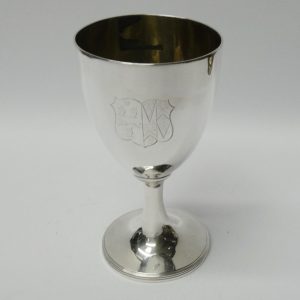Peter & William Bateman
Peter, Anne and William Bateman were the son, daughter-in-law (widow of Jonathan) and grandson of Hester Bateman, probably the most well known of all English lady silversmiths whose work is highly collectible.
Hester married the goldsmith John Bateman in 1732, and together they worked a small silversmith business. Following the death of her husband in 1760 she successfully ran her family business for thirty years and was succeeded in turn by her sons, grandson and great-grandson and the Bateman family silversmithing company lasted until the middle of the nineteenth century.
Hester had at least five children – Jonathan, Peter, probably John (who may have been connected with the business, although he is only recorded as a watch and clock-maker), Letitia (who married Richard Clarke), and Ann. Only Peter, Letitia, and Ann were still living at the time of Hester’s death. Hester registered her mark at Goldsmith’s Hall ‘April 16, 1761, as Hester Bateman in Bunnhill Row and this mark was used until 1790. Hester died in 1794.
1790 registered mark of her sons PETER BATEMAN and JOHN BATEMAN. This partnership was of short duration as Jonathan, who married Ann Downlinff, died in 1791. 1791 registered mark PETER and ANN BATEMAN, Jonathan’s widow.
1800 registered mark PETER BATEMAN, ANN BATEMAN and WILLIAM (I) BATEMAN. William Bateman was the son of Jonathan and Ann Bateman who in 1800 entered in partnership with his uncle Peter and his mother Ann.
1805, after the retirement of Ann, registered mark PETER BATEMAN and WILLIAM (I) BATEMAN.
From 1815 to 1840 WILLIAM (I) BATEMAN was registered alone.
From 1839 to 1843 WILLIAM (II) BATEMAN (son of William I) & DANIELL BALL.
Peter & William Bateman
Peter, Anne and William Bateman were the son, daughter-in-law (widow of Jonathan) and grandson of Hester Bateman, probably the most well known of all English lady silversmiths whose work is highly collectible.
Hester married the goldsmith John Bateman in 1732, and together they worked a small silversmith business. Following the death of her husband in 1760 she successfully ran her family business for thirty years and was succeeded in turn by her sons, grandson and great-grandson and the Bateman family silversmithing company lasted until the middle of the nineteenth century.
Hester had at least five children – Jonathan, Peter, probably John (who may have been connected with the business, although he is only recorded as a watch and clock-maker), Letitia (who married Richard Clarke), and Ann. Only Peter, Letitia, and Ann were still living at the time of Hester’s death. Hester registered her mark at Goldsmith’s Hall ‘April 16, 1761, as Hester Bateman in Bunnhill Row and this mark was used until 1790. Hester died in 1794.
1790 registered mark of her sons PETER BATEMAN and JOHN BATEMAN. This partnership was of short duration as Jonathan, who married Ann Downlinff, died in 1791. 1791 registered mark PETER and ANN BATEMAN, Jonathan’s widow.
1800 registered mark PETER BATEMAN, ANN BATEMAN and WILLIAM (I) BATEMAN. William Bateman was the son of Jonathan and Ann Bateman who in 1800 entered in partnership with his uncle Peter and his mother Ann.
1805, after the retirement of Ann, registered mark PETER BATEMAN and WILLIAM (I) BATEMAN.
From 1815 to 1840 WILLIAM (I) BATEMAN was registered alone.
From 1839 to 1843 WILLIAM (II) BATEMAN (son of William I) & DANIELL BALL.
-


1805
Peter & William Bateman
8979 George III Silver Goblet
Sold
An elegant antique sterling silver drinking chalice with a tapering bowl on a spreading base. Classic plain style and borders. Original bright gilt interior. Hand engraved to the front is a good family armorial within a shield. Contains 250 ml. Weight 187 grams, 8.1 troy ounces. Height 11.8 cms. Diameter 6 cms. London 1805. Maker Peter & William Bateman.